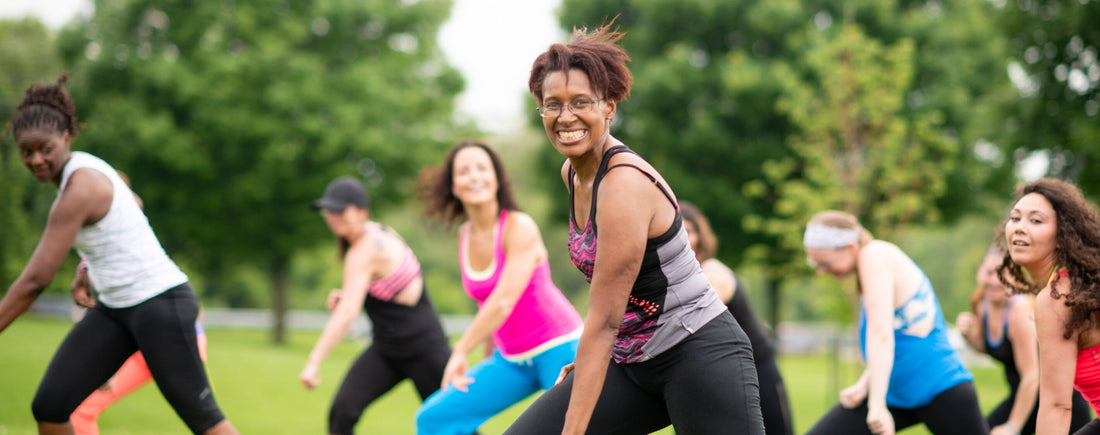It is safe to say that you are aware that exercise is healthy. Still, for many, the word “exercise” is weighed down with feelings of stress and obligation. When did the simple act of moving your body become such a drag? Another word for exercise is simply movement. Moving should never be burdensome as it is one of your body’s most basic functions!
Looking for some renewed motivation to move your body as the days get shorter and the weather colder? The following are reasons—other than weight loss—to move your body. By focusing on non-weight related reasons to move, you can help yourself foster feelings of joy around movement, rather than dread.
Exercise may also help individuals cope with stress. In one study, participants were asked to complete both a non-stressful control task and a stressful task. Those participants who exercised at least once weekly had better moods following the stressful task than the non-exercisers, who reported a significant decline in positive affect (mood) and felt generally “unfriendly” following the stressful task. These results suggest that routine exercise, while not necessarily preventing you from feeling acute stress, is helpful in maintaining a positive mood and preventing stress from accumulating in your body.
Unlike the circulatory or respiratory systems, the lymphatic system does not have a “pump.” Instead, it relies on your motion to circulate lymph fluid around the body. Each time you move large muscles of the body, you help pump lymphatic fluid through your body, keeping your systems circulating.
The bone-building effects of exercise are important across your lifespan. For children, physical activity is essential to help create dense bones, as children are continuously building bones until around age 20, at which point they have accumulated nearly 90 percent of the total bone mass they will have throughout their lives.
After your thirties, bone mass starts to decline. Muscular disorders such as osteoporosis are a leading cause of disability in the elderly, leaving individuals susceptible to fractures. While some degree of bone loss is unavoidable, exercise is one of the main steps you can take to help maintain bone mass.
For women, regularly moving the body may help to increase sexual function and arousal. The mechanism requires further study, though may be related to increased hormone production as well as endorphins.
*Editor’s Note: The information in this article is intended for your educational use only and is not a substitute for professional medical advice, diagnosis, or treatment. Always seek the advice of your physician or other qualified health providers with any questions you may have regarding a medical condition and before undertaking any diet, supplement, fitness, or other health programs.
Join Chopra for the Journey to Well-being, a brand new guided experience in self-discovery, with free monthly programs for mind, body, and spirit. Register now!
Looking for some renewed motivation to move your body as the days get shorter and the weather colder? The following are reasons—other than weight loss—to move your body. By focusing on non-weight related reasons to move, you can help yourself foster feelings of joy around movement, rather than dread.
1. Enhanced Mood
Moving your body not only improves mood, but also helps combat anxiety and depression. Data show that exercise provides these benefits both in healthy individuals as well as those with diagnosed emotional disorders, regardless of sex and age.Exercise may also help individuals cope with stress. In one study, participants were asked to complete both a non-stressful control task and a stressful task. Those participants who exercised at least once weekly had better moods following the stressful task than the non-exercisers, who reported a significant decline in positive affect (mood) and felt generally “unfriendly” following the stressful task. These results suggest that routine exercise, while not necessarily preventing you from feeling acute stress, is helpful in maintaining a positive mood and preventing stress from accumulating in your body.
2. Healthier Lymph
The lymphatic system is part of your body’s immune system. When you have a sore throat and feel a lump in your neck, you may rub it and say you think your lymph nodes are swollen, but typically this is where your knowledge ends. The lymph system is a series of channels and nodes dispersed throughout the body that move lymph fluid. Lymph fluid contains infection-fighting white blood cells throughout the body. It is an important part of the immune system because it is responsible for removing potentially harmful toxins and bacteria from the body.Unlike the circulatory or respiratory systems, the lymphatic system does not have a “pump.” Instead, it relies on your motion to circulate lymph fluid around the body. Each time you move large muscles of the body, you help pump lymphatic fluid through your body, keeping your systems circulating.
3. Healthier Bones
Exercise is not just good for your muscles. When your muscles push and pull against bones, this also helps to build and preserve bone mass. Weight-bearing exercise is best for building bone mass. This doesn’t mean that you have to use weights. Any sustained activity in which you work against the force of gravity, such as walking, dancing, or taking the stairs, helps to build bone mass. Keep in mind that the higher the impact, the greater the benefit to bone growth.The bone-building effects of exercise are important across your lifespan. For children, physical activity is essential to help create dense bones, as children are continuously building bones until around age 20, at which point they have accumulated nearly 90 percent of the total bone mass they will have throughout their lives.
After your thirties, bone mass starts to decline. Muscular disorders such as osteoporosis are a leading cause of disability in the elderly, leaving individuals susceptible to fractures. While some degree of bone loss is unavoidable, exercise is one of the main steps you can take to help maintain bone mass.
4. Enhanced Brain Health
Exercise improves cognitive performance for people of all ages. In one study, children who participated in physical activity demonstrated increased electrical activity in the brain, as well as improved mental accuracy and reaction times. Another study confirmed what you can rationally infer—that a healthy workout routine early on in life may help to predict your level of cognitive decline later in life. Individuals who were physically active at 18 years old were less likely, 42 years later, to have developed early onset dementia or mild cognitive impairment.5. Improved Sex Life
Exercise improves sex life (arousal and satisfaction) for both men and women. For men, not only does increased blood flow improve sexual function, but regular exercise also helps with psychosocial factors such as mood, stress, and confidence which may contribute to feeling “in the mood.” Furthermore, regular weight-lifting and interval cardiovascular exercise may increase testosterone levels by building muscle mass—a precursor to testosterone production. Testosterone is a stress hormone directly linked with sex drive and performance. (It should be noted that chronic endurance exercise, such as endurance cycling and running, actually decrease testosterone. While these activities are still healthy, they may not be best for maximizing sexual health.)For women, regularly moving the body may help to increase sexual function and arousal. The mechanism requires further study, though may be related to increased hormone production as well as endorphins.
8 Ways to Move
If “working out” carries a negative vibe for you, try not to think of it that way! Moving your body is healthy, and should feel good—however you do it. Below are some suggestions of ways to move your body.- Window shop: Take a stroll downtown or through the mall and browse!
- Dance: Put on some favorite music and move in all of the ways that feel good. Dancing is wonderful exercise, as it incorporates standing weight-bearing exercise such as lunging or twirling with range-of-motion exercises such as arm sweeps and hip swings. Next time you spend time cleaning the house or getting ready in the morning, put on some tunes and incorporate dance.
- Garden: Gardening often involves walking, squatting, reaching, and pushing/pulling. All healthy ways to move!
- Stretch: Stretching your body not only helps to move lymph fluid, but also helps to keep you joints flexible and lubricated. Stretch while watching TV, listening to music, or talking on the phone.
- Tone while grocery shopping: When feasible, use a shopping basket rather than a push cart. By carrying a basket around, you will be performing weight-bearing exercise for your arms while strolling around the supermarket.
- Play with your children: Kiddos are some of the highest calorie burners, and they don’t even realize it—they play just for the joy of it. Engage in a game of tag or hide-and-seek, and forget the exercise—focus on the fun.
- Enjoy the outdoors: Take a walk or bike ride, hike or ski, snow shoe or jog. Moving your body outdoors adds a double bonus of exposing yourself to nature, which packs in a slew of additional mental health benefits.
- Take a class with a friend: The options are endless. From salsa to yoga, water aerobics to Pilates. Taking a class helps you reap the benefits of socialization as well as continued learning, both of which contribute to cognitive health and well-being.
*Editor’s Note: The information in this article is intended for your educational use only and is not a substitute for professional medical advice, diagnosis, or treatment. Always seek the advice of your physician or other qualified health providers with any questions you may have regarding a medical condition and before undertaking any diet, supplement, fitness, or other health programs.
Join Chopra for the Journey to Well-being, a brand new guided experience in self-discovery, with free monthly programs for mind, body, and spirit. Register now!






















